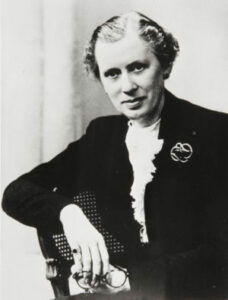Dr Margaret Fairlie

Margaret Fairlie (1891-1963) was born on West Balmirmer Farm, Angus. She studied medicine at the University of St Andrews and University College Dundee, graduating in 1915. Dr Fairlie began working at Dundee Royal Infirmary and teaching in the medical school in 1920.
Dr Fairlie eventually became Head of Clinical Gynaecology in Dundee and Professor of Obstetrics and Gynaecology in St Andrews, despite opposition from the University Board. Adverse in the ability to overcome obstacles as a woman in a male-dominated field, she became the first female professor in Scotland.
Dr Fairlie pioneered the clinical use of radium in Scotland, championed women’s health and greatly improved pre and ante-natal care across Dundee, Fife and Angus before retiring to St Andrews in 1956. Margaret Fairlie died in July 1963 at the age of 72.
Contributions
After graduating from St Andrews, Margaret Fairlie studied Obstetrics, Gynaecology and Midwifery in Manchester and qualified as a surgeon in Dundee in 1922. In addition to her position in Dundee Royal Infirmary, she worked as a visiting surgeon and consultant for smaller hospitals across Dundee, Angus, and Fife, including the St Andrews’ Cottage Hospital.
In 1926, Dr Fairlie visited the Marie Curie Foundation in Paris. Upon her return, she pioneered the use of radium in cancer treatment in Scotland, specifically within gynaecology. She also ran a follow-up clinic for the patients she treated and upon her retirement, expressed her pride at the success of this work, with some patients attending her clinic for over 20 years.[1]


Dr Fairlie also developed a predecessor of the modern smear test used to diagnose cervical cancer. Furthermore, she was dedicated to improving women’s health during and after pregnancy, and to reducing infant mortality. She helped set up Dundee’s first ante-natal clinic, once claiming that the babies she had delivered, if laid out in a row, would stretch from Dundee to beyond Perth![2]
[1] (Richardson, 1956) – ‘One aspect of my work which has given me especial satisfaction and delight has been my continuity with the patients who attend the radium follow-up clinic… some of whom have been coming for 20 years. The atmosphere at this clinic is one of trust, gratitude and mutual affection.’
[2] (Richardson, 1956)
Evidently not one to be intimidated, Margaret Fairlie drove ambulances for the Red Cross hospital in Royaumont, France, during WWI and became a pioneer of commercial flight when she travelled to Johannesburg via Comet in 1952.[1]
Personal Information
She never married – her engagement to a colleague, Professor Lloyd Turton Price, ended tragically with his premature death in 1933 – but she was well loved by her students whose gifts of appreciation included a cactus garden: a nod to her love of plants.[2]
Affectionately known as ‘Madam’ by colleagues and students alike, she was widely respected and, among other accolades, became a founding member of the Women’s Visiting Gynaecological Club – a group of 20 women fellows of the Royal College of Obstetricians and Gynaecologists who met yearly in teaching hospitals across the country.

[1] http://www.scarletfinders.co.uk/137.html – List of drivers and other workers at Royaumont (30km North of Paris), a hospital run under the French Red Cross by the Scottish Women’s Hospitals (SWH) organisation. Comet was the world’s first commercial airliner.
[2] (Death of Professor L. Turton Price, the Eminent Dundee Surgeon, 1933) (Richardson, 1956)
